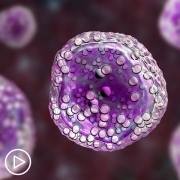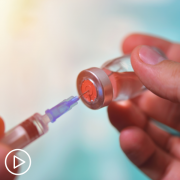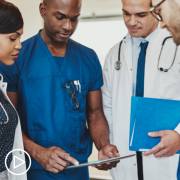Diffuse Large B-Cell Lymphoma (DLBCL) Treatment and Research News
Diffuse Large B-Cell Lymphoma (DLBCL) Treatment and Research News from Patient Empowerment Network on Vimeo.
What’s the latest diffuse large B-cell lymphoma (DLBCL) treatment and research news? Dr. Jean Koff explains study findings shared at the recent American Society of Clinical Oncology (ASCO) 2021 meeting and what they could mean for the future of DBCL treatments.
Dr. Jean Koff is an Assistant Professor in the Department of Hematology and Oncology at Winship Cancer Institute at Emory University. Learn more about Dr. Koff, here.
See More From The Pro-Active DLBCL Patient Toolkit
Related Programs:

|
Transcript:
Katherine Banwell:
Cancer researchers came together recently to share findings at the annual American Society of Clinical Oncology meeting. Also known as ASCO. Are there highlights from the meeting that patients should know about?
Dr. Koff:
Well, I think at every meeting, there are lots of exciting updates to possible treatments for DLBCL. I think with the recent ASCO meeting, what a lot of researchers and clinicians are excited about are treatments in the relapse setting for DLBCL. So, there may be shifts where we are more likely to use immunotherapies known as CAR T-cells rather than what we have standardly used for patients who have relapsed after their frontline therapy.
So, that’s one of the exciting updates and we’re eager to see more details on this data. But one of the other exciting areas that we’re following closely in and ask were there several updates are a newer class of drugs, a type of immunotherapy known as fites. And these are immunotherapies that help to target the lymphoma by binding to a marker on the lymphoma tumor surface and recruiting your own immune system to attack the lymphoma. And so, we’re getting more results from clinical trials from lots of these types of agents that are showing very promising results in patients who have relapsed DLBCL.
Katherine Banwell:
What are you excited about when it comes to DLBCL research?
Dr. Koff:
So, I’m very excited about what we call precision medicine.
Which is matching a variety of treatments that we have to what is best for an individual patient. Based on the factors we talked about, like the patient level factors, but more importantly the tumor level factors. Things like gene abnormalities or even abnormalities in the patient’s immune system. We’re still in the infancy of really getting a good understanding of how these molecular factors might be matched to an ideal treatment. But that to me is really the future is matching these patients based on their tumor profiles with a treatment that is the most likely to control the lymphoma, get rid of the lymphoma and offer patients a cure.








